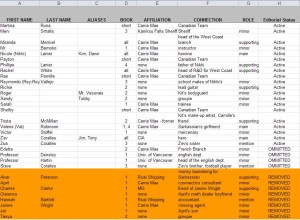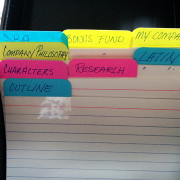Organizing My World(s)
An author’s job is not just to tell a story, but to decide how a story should be told. Is it better in first or third person? Is it told in one long march of words or are their chapters? We have to decide genre, tone and feeling. And once those decisions have been made an author must create and track the main plot of the story – the one that we struggle to capture in the blurb text on the back cover – as well as the sub-plots, underlying themes, and finally, the characters themselves. All of those pieces require not just the ability to write, but also the ability to track information. Because, as any serious reader will tell you (sometimes at great length), consistency and details matter greatly to a well written book, and while we can rely on an editor for some items, they are only human and can only catch so much. It is in an author’s best interest to provide the cleanest manuscript possible.
I’m currently working on two vastly different stories: the fourth Carrie Mae Mystery Glossed Cause and a Romance Horror novella Wild Waters. Each story comes with an array of characters, research and plot twists that to be perfectly honest I can’t hold in my brain. Possibly pre-production of a toddler I could have kept hold of all the details, but no longer. Now, to keep all my worlds organized, I must rely on a system of notes, plot outlines and spreadsheets.
 For the Carrie Mae books I track characters with a spread sheet that notes who they are (name, basic role, job or company) and also what book they have appeared in or if they have been deleted or omitted from a book. I also have a rather extensive style sheet that helps me keep track of how certain things, such as chapter headings are formatted and whether or not I’m consistently formatting things like “AK-47” and “INTERPOL” the same way over multiple books.
For the Carrie Mae books I track characters with a spread sheet that notes who they are (name, basic role, job or company) and also what book they have appeared in or if they have been deleted or omitted from a book. I also have a rather extensive style sheet that helps me keep track of how certain things, such as chapter headings are formatted and whether or not I’m consistently formatting things like “AK-47” and “INTERPOL” the same way over multiple books.
 For Wild Waters I’m writing in two different time periods – WWII and Vietnam – and they each use distinctive slang that I organize in a couple of basic lists. There are also multiple character points of view and it is important to keep track of what characters know and when they know it, so that each plot point is revealed at the correct time. Tracking character arcs are more difficult and sometimes require multiple ways of visualizing. I will frequently write out the plot from each characters point of view or I will graph it out on a virtual whiteboard, utilizing the main plot points.
For Wild Waters I’m writing in two different time periods – WWII and Vietnam – and they each use distinctive slang that I organize in a couple of basic lists. There are also multiple character points of view and it is important to keep track of what characters know and when they know it, so that each plot point is revealed at the correct time. Tracking character arcs are more difficult and sometimes require multiple ways of visualizing. I will frequently write out the plot from each characters point of view or I will graph it out on a virtual whiteboard, utilizing the main plot points.
There is no perfect system of course, and each author must work the way that works for them. But when examining a well-written book, I am frequently in awe, not just of the beautifully constructed words or strong turn of phrase, but the underlying construction of a book. Sometimes, I find it amazing that any books get written at all.


